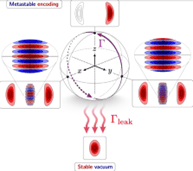
An English proverb states, “A cat has nine lives. For three he plays, for three he strays, and for the last three he stays.” In the quantum world, however, objects can be in a superposition of states simultaneously. Therefore, a quantum cat could exist in a superposition of playing, straying, and staying all at once.
Though the literal quantum cat might sound like science fiction, so-called “cat states” – semi-classical states that exhibit properties of quantum superpositions – are real. What is more, they could be central to the development of quantum computers, which are machines that leverage the power of quantum mechanics to solve problems. The challenge is finding ways to control them, and researchers at the EPFL in Switzerland recently made a breakthrough in this field. By optimizing a particular control parameter, they identified a way to make quantum bits (qubits) based on cat states much more resilient to certain types of errors.
A famous thought experiment
The concepts of cat states was inspired by Erwin Schrödinger’s famous thought experiment in which a cat is both alive and dead until it is observed. The paradoxical picture represents a bridge between the microscopic quantum world of atoms and molecules and the macroscopic classical world.
Moving computing across that bridge would represent a paradigm shift in our computational capabilities, as a large-scale quantum computers could solve problems beyond the reach of classical machines. Yet, today’s quantum devices grapple with significant scalability challenges.
Central to the journey toward fully functional and scalable quantum hardware is the battle against noise, which compromises the reliability of quantum computations and necessitates sophisticated strategies for correcting noise-induced errors.
Schrödinger cat states: quantum superpositions as information carriers
Schrödinger cat states stand out as a particularly promising way of combatting these errors. In many platforms, these cat states are created by superimposing a coherent (mostly classical) state of light that has a defined phase (say, the “alive” state) with another state of opposite phase (the “dead” state). While the coherent states encode the equivalent of 0 and 1 in classical logic, the power of quantum computing lies in the possibility of accessing any superposition of the two – that is, the cat states, which are the states of a quantum harmonic oscillator.

One factor that distinguishes qubits based on cat states from other proposals to encode quantum information is their intrinsic resilience to so-called bit-flip errors, which occur when the system passes randomly between the logical 0 and 1 state. Such passage can be envisioned as a pendulum, where the state 0 is to the left of the equilibrium point and state 1 is to the right. Implementing “cat codes” that exploit this resilience, however, poses several challenges, as it is difficult to generate cat states while maintaining compatibility with everything the operators needed to perform quantum computations (such as quantum gates and readout measurements).
Innovations in error suppression
In the recent work, Luca Gravina, Fabrizio Minganti and Vincenzo Savona of the EPFL’s Laboratory of Theoretical Physics of Nanosystems identified an additional and largely overlooked control parameter: the detuning, or difference in frequencies, between the force driving the “pendulum” and the resonant frequency of the quantum harmonic oscillator. This parameter has drastic influence over cat qubit properties, and getting it right enhances the qubit’s resilience to bit-flip errors by several orders of magnitude.
The EPFL researchers thoroughly investigated the nature of such an improvement in all operational regimes of the qubit. In particular, they tied it to the presence of dissipative criticality in the form of a first-order dissipative phase transition. In the context of cat qubits, dissipative criticality is a scheme that combines a two-photon drive and a two-photon loss to stabilize the operation of such qubits.
The researchers demonstrated that it is possible to access a peculiarly favourable regime of operation in these driven-dissipative non-linear resonators operated near the phase transition. The metastable nature of this encoding also makes it possible to draw parallels between quantum information and dissipative criticality, connecting the concepts of noise suppression in cat states and the spectral theory of Liouvillians, which is normally used to described critical phenomena.

Cat qubits reach a new level of stability
The EPFL team’s findings underscore that carefully tuning the various parameters (non-linearity, two-photon dissipation and detuning) that characterize the devices where cat states are generated can enhance the performance of cat codes beyond current levels. This, in turn, would pave the way towards the realization of scalable quantum devices.
In the future, Gravina and colleagues aspire to simulate how non-linearity, dissipation and higher-order non-linearities can be resources. As well as applying their findings to a variety of physical models, they expect to investigate the role of dissipative criticality and use the results to explore how different codes can achieve an analogous enhancement in performance.
The study is published in PRX Quantum.
- SEO Powered Content & PR Distribution. Get Amplified Today.
- PlatoData.Network Vertical Generative Ai. Empower Yourself. Access Here.
- PlatoAiStream. Web3 Intelligence. Knowledge Amplified. Access Here.
- PlatoESG. Carbon, CleanTech, Energy, Environment, Solar, Waste Management. Access Here.
- PlatoHealth. Biotech and Clinical Trials Intelligence. Access Here.
- Source: https://physicsworld.com/a/schrodingers-cat-makes-a-better-qubit-in-critical-regime/



